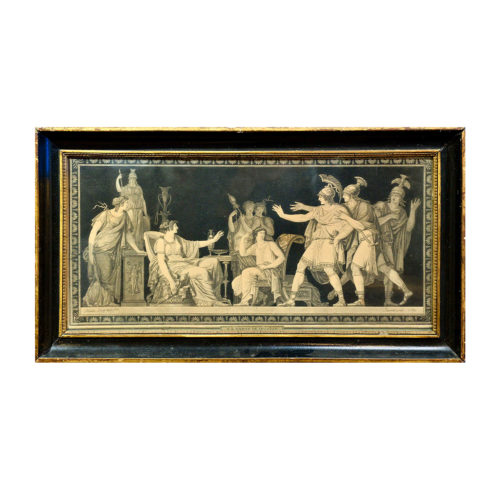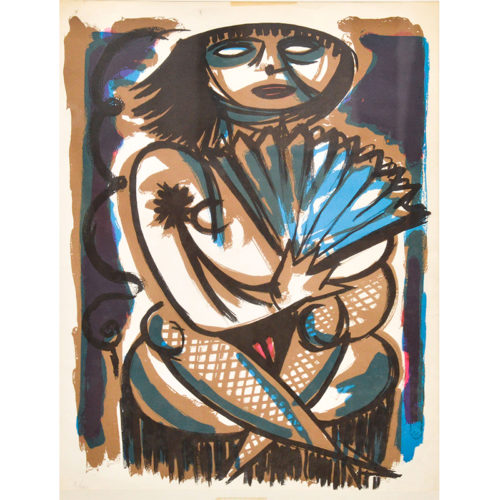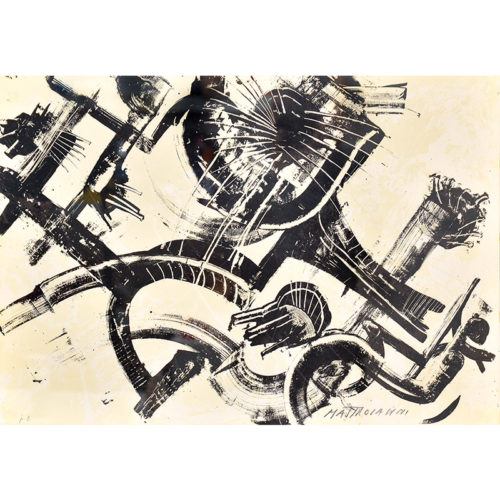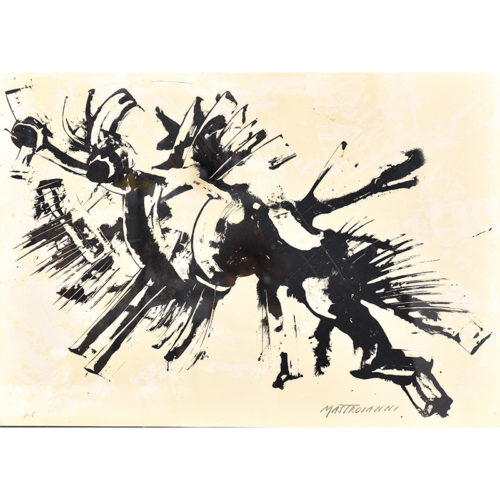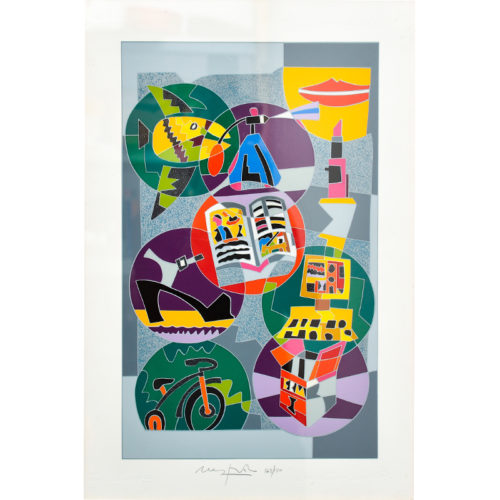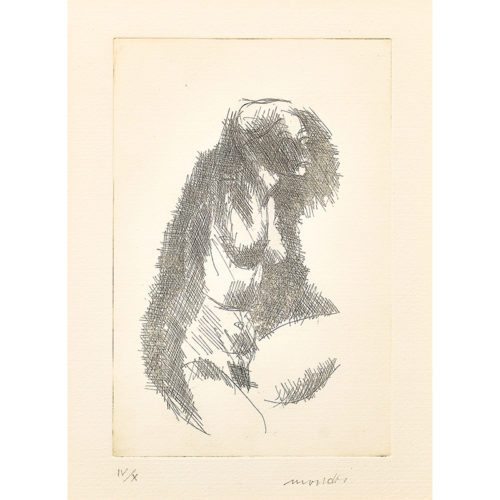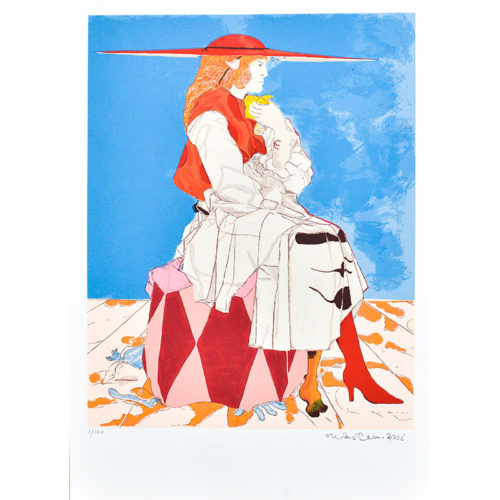"La Vertu de Lucrèce", Etching, aquatint by Jean-François Janinet (1752-1814), dating back to 1789
-
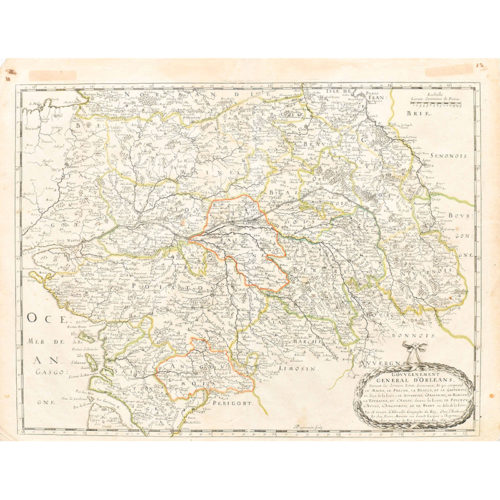 Beautiful example of the engraved map of Nicolas Sanson d'Abbeville from 1650. Nicolas Sanson (1600-1667), sometimes called Nicolas Sanson d'Abbeville or Sanson d'Abbeville, was the most important French cartographer of the 17th century. Tooley called Sanson "the founder of the French school of cartography". He started making cards at the end of 1620, and in 1630 he worked with Melchior Tavernier. Subsequently, Sanson worked in concert with the publisher Pierre Mariette, with whom he published his great atlas: general maps of all parts of the world (1658). After Sanson's death in 1667, his son Guillaume ran the business in collaboration with Alexis Hubert Jaillot. Guillaume has established himself as a full-fledged very important French cartographer.Period: 1650 Measurements: In frame H 65 X L 79 / Paper H 44 X L 56 cm
Beautiful example of the engraved map of Nicolas Sanson d'Abbeville from 1650. Nicolas Sanson (1600-1667), sometimes called Nicolas Sanson d'Abbeville or Sanson d'Abbeville, was the most important French cartographer of the 17th century. Tooley called Sanson "the founder of the French school of cartography". He started making cards at the end of 1620, and in 1630 he worked with Melchior Tavernier. Subsequently, Sanson worked in concert with the publisher Pierre Mariette, with whom he published his great atlas: general maps of all parts of the world (1658). After Sanson's death in 1667, his son Guillaume ran the business in collaboration with Alexis Hubert Jaillot. Guillaume has established himself as a full-fledged very important French cartographer.Period: 1650 Measurements: In frame H 65 X L 79 / Paper H 44 X L 56 cm -
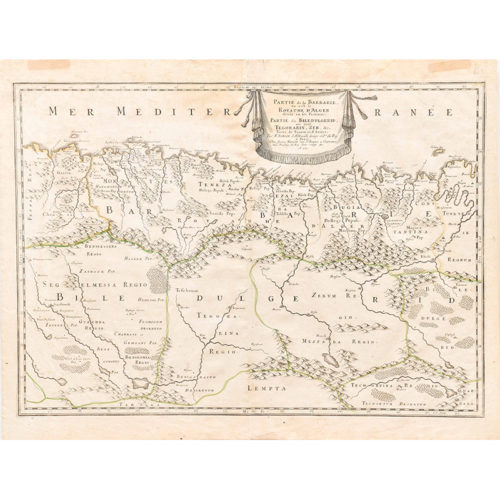 Beautiful example of the engraved map of Nicolas Sanson d'Abbeville from 1655 on the Algerian coast of North Africa. Nicolas Sanson (1600-1667), sometimes called Nicolas Sanson d'Abbeville or Sanson d'Abbeville, was the most important French cartographer of the 17th century. Tooley called Sanson "the founder of the French school of cartography". He started making cards at the end of 1620, and in 1630 he worked with Melchior Tavernier. Subsequently, Sanson worked in concert with the publisher Pierre Mariette, with whom he published his great atlas: general maps of all parts of the world (1658). After Sanson's death in 1667, his son Guillaume ran the business in collaboration with Alexis Hubert Jaillot. Guillaume has established himself as a full-fledged very important French cartographer. Period: 1655 Measurements: In frame H 65 X L 79 / Paper H 44 X L 56 cm
Beautiful example of the engraved map of Nicolas Sanson d'Abbeville from 1655 on the Algerian coast of North Africa. Nicolas Sanson (1600-1667), sometimes called Nicolas Sanson d'Abbeville or Sanson d'Abbeville, was the most important French cartographer of the 17th century. Tooley called Sanson "the founder of the French school of cartography". He started making cards at the end of 1620, and in 1630 he worked with Melchior Tavernier. Subsequently, Sanson worked in concert with the publisher Pierre Mariette, with whom he published his great atlas: general maps of all parts of the world (1658). After Sanson's death in 1667, his son Guillaume ran the business in collaboration with Alexis Hubert Jaillot. Guillaume has established himself as a full-fledged very important French cartographer. Period: 1655 Measurements: In frame H 65 X L 79 / Paper H 44 X L 56 cm -
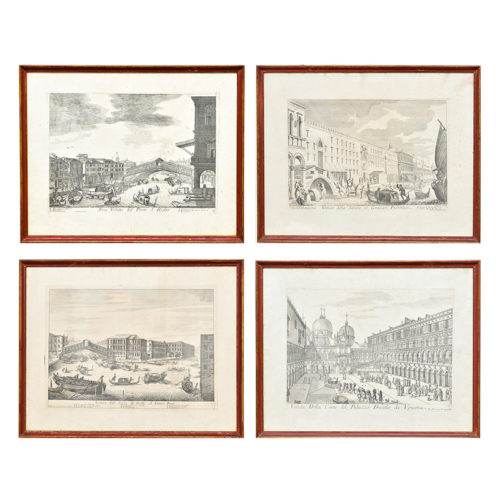 Period: 1717 Measurements: In frame H 53 x L 67 / Paper H 48 x L 61 cm"Venice" - Lithographs by Filippo Vasconi (1687 - 1730) for Domenico Lovisa (1690 - 1750), dating back to 1717. The four lithographs represent:
Period: 1717 Measurements: In frame H 53 x L 67 / Paper H 48 x L 61 cm"Venice" - Lithographs by Filippo Vasconi (1687 - 1730) for Domenico Lovisa (1690 - 1750), dating back to 1717. The four lithographs represent:- "View of the Court of the Doge's Palace in Venice" from The Gran Teatro di Venezia
- "View of the Rialto Island with the Famous Bridge" from The Gran Teatro di Venezia
- "View of Health and Public Granaries" from The Gran Teatro di Venezia
- "Other View of the Rialto Bridge" from The Gran Teatro di Venezia
-
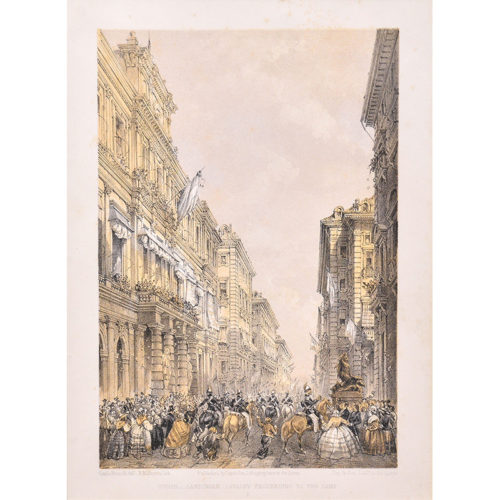 Lithograph by Carlo Bossoli representing the perspective view of the Palazzo di Città and the current via Milano (Turin) in which, in a blaze of cheering crowds, the Piedmontese cavalry leaving for the war parades on 17 April 1859. Signed by the author .Period: 1859 Measurements: H 22.5 x L 15.3 cmPeriod: 1859
Lithograph by Carlo Bossoli representing the perspective view of the Palazzo di Città and the current via Milano (Turin) in which, in a blaze of cheering crowds, the Piedmontese cavalry leaving for the war parades on 17 April 1859. Signed by the author .Period: 1859 Measurements: H 22.5 x L 15.3 cmPeriod: 1859 -
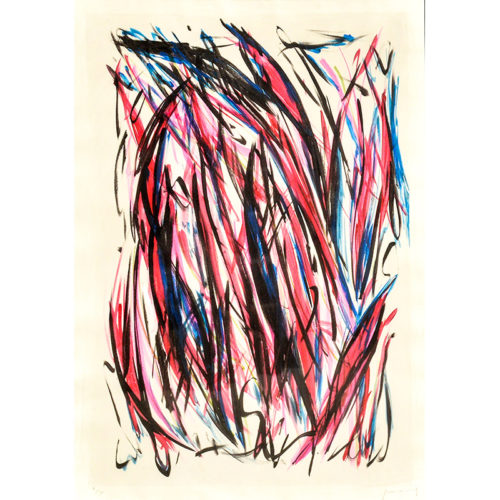 Color lithograph, copy 9 on a print run of 50, made in 2001 by Emilio Vedova (Venice, August 9, 1919 - Venice, October 25, 2006) was an Italian painter and engraver. "Now I will no longer worry about cutting clear profiles, exact angles of light and shadow, but light and shadow will come directly from my intimate, concerned only with transmitting the image without any a priori revisionism, which I had felt for many years." (Cit. Widow)Period: 2001 Measurements: In frame H 123 x L 92 cm / Paper H 97 x L 73 cm
Color lithograph, copy 9 on a print run of 50, made in 2001 by Emilio Vedova (Venice, August 9, 1919 - Venice, October 25, 2006) was an Italian painter and engraver. "Now I will no longer worry about cutting clear profiles, exact angles of light and shadow, but light and shadow will come directly from my intimate, concerned only with transmitting the image without any a priori revisionism, which I had felt for many years." (Cit. Widow)Period: 2001 Measurements: In frame H 123 x L 92 cm / Paper H 97 x L 73 cm -
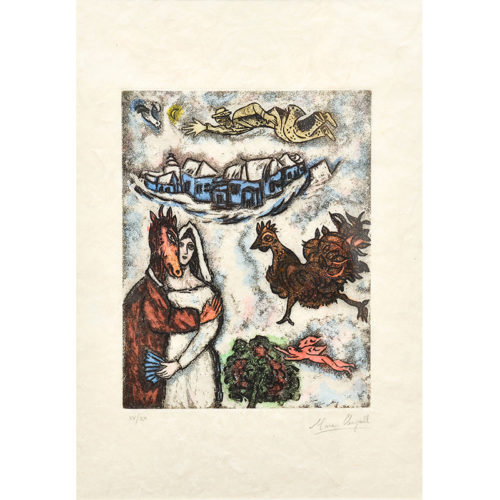 Lithograph on Japanese paper by Marc Chagall (Lëzna, 7 July 1887 - Saint-Paul-de-Vence, 28 March 1985), was a French Russian-born painter of Hasidic Jewish origin. Numbered lithograph (XV / XX) on the bottom left, with the signature on the bottom right.Period: 70s Measurements: In frame H 72.5 x L 53 cm / Sheet H 49 x L 34.5 cm
Lithograph on Japanese paper by Marc Chagall (Lëzna, 7 July 1887 - Saint-Paul-de-Vence, 28 March 1985), was a French Russian-born painter of Hasidic Jewish origin. Numbered lithograph (XV / XX) on the bottom left, with the signature on the bottom right.Period: 70s Measurements: In frame H 72.5 x L 53 cm / Sheet H 49 x L 34.5 cm -
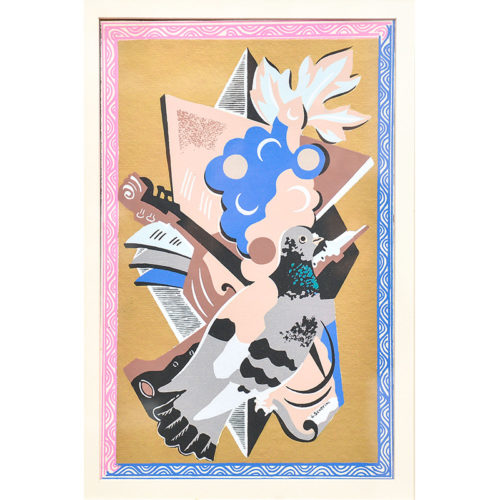 Multiple print on Lafuma paper entitled "Nature Morte au Pigeon" by Gino Severini (Cortona 1883 - Paris 1966) Thirteenth table in the folder "Fleures et Masques" by G. Severini published in London in 1930. "Fleurs et masques" is made up of 16 engraved and colored plates "au pochoirs", it has a unique edition of 125 copies. The author was among the signatories in 1909 of the Manifesto of Futurism written by Filippo Tommaso Marinetti. In Paris he was in contact with Pablo Picasso, Georges Braque, Juan Gris and Guillaume Apollinaire, and participated in the birth and development of Cubism. Technique: PouchoirPeriod: 1930 Measurements: In frame H 56 x L 44 cm / Print H 35 x L 21.5 cm
Multiple print on Lafuma paper entitled "Nature Morte au Pigeon" by Gino Severini (Cortona 1883 - Paris 1966) Thirteenth table in the folder "Fleures et Masques" by G. Severini published in London in 1930. "Fleurs et masques" is made up of 16 engraved and colored plates "au pochoirs", it has a unique edition of 125 copies. The author was among the signatories in 1909 of the Manifesto of Futurism written by Filippo Tommaso Marinetti. In Paris he was in contact with Pablo Picasso, Georges Braque, Juan Gris and Guillaume Apollinaire, and participated in the birth and development of Cubism. Technique: PouchoirPeriod: 1930 Measurements: In frame H 56 x L 44 cm / Print H 35 x L 21.5 cm -
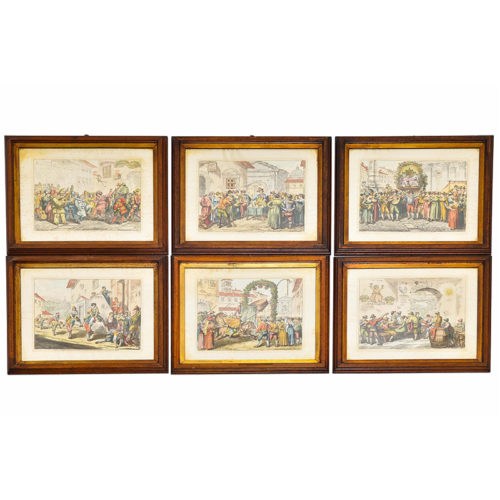 Group of 6 prints depicting the carnival in Rome by Bartolomeo Pinelli (Rome, 20 November 1781 - Rome, 1 April 1835). He was an Italian engraver, painter and ceramist. Extremely prolific graphic artist, it has recently been estimated that he produced about four thousand engravings and ten thousand drawings. In his prints he illustrated the customs of the Italian peoples, the great masterpieces of literature: Virgil, Dante, Tasso, Ariosto, Cervantes, Manzoni, and subjects of Roman, Greek, Napoleonic history etc. The most common theme in general is Rome, its inhabitants, its monuments, the ancient city and the one that is contemporary to him. The well-known portrait painter Giuseppe Tominz from Gorizia had among his students. In addition to its intrinsic artistic value, his illustrator work has significant documentary significance for the ethnography of Rome, Italy and Switzerland.Period: 1940s Measurements: In frame H 49 x L 60 / Prints H 40 x L 51 cm
Group of 6 prints depicting the carnival in Rome by Bartolomeo Pinelli (Rome, 20 November 1781 - Rome, 1 April 1835). He was an Italian engraver, painter and ceramist. Extremely prolific graphic artist, it has recently been estimated that he produced about four thousand engravings and ten thousand drawings. In his prints he illustrated the customs of the Italian peoples, the great masterpieces of literature: Virgil, Dante, Tasso, Ariosto, Cervantes, Manzoni, and subjects of Roman, Greek, Napoleonic history etc. The most common theme in general is Rome, its inhabitants, its monuments, the ancient city and the one that is contemporary to him. The well-known portrait painter Giuseppe Tominz from Gorizia had among his students. In addition to its intrinsic artistic value, his illustrator work has significant documentary significance for the ethnography of Rome, Italy and Switzerland.Period: 1940s Measurements: In frame H 49 x L 60 / Prints H 40 x L 51 cm -
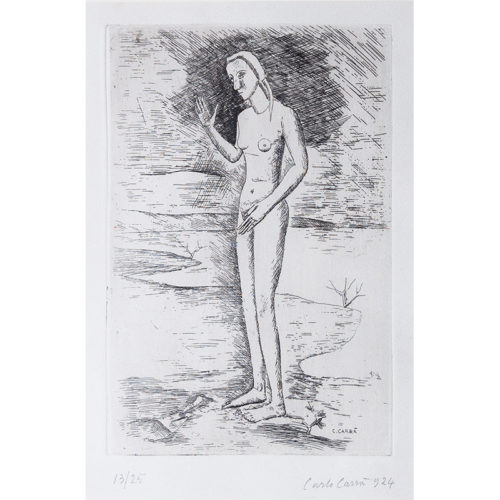 The birth of Venus, work of 1923, signed and dated 1924 in the lower right and numbered in the lower left 13/25 by the author Carlo Dalmazio Carrà (Quargnento, 11 February 1881 - Milan, 13 April 1966), Italian painter and teacher , professor at the Brera Academy from 1939 to 1951. This work is part of the "transcendent period" of the painter who since 1922 abandoned metaphysics, driven by the desire to "be only himself". Painting must grasp that relationship which includes the need to identify with things and the need for abstraction "and the contemplation of the landscape is then resolved in the" construction "of a painting, both mountain and marine. He also knows the Milanese painter-poet Cesare Breveglieri (who portrayed him while he was painting).Period: 1924 Measurements: In frame H 53.5 x L 41.5 / Paper H 31 x L 20.6 cm
The birth of Venus, work of 1923, signed and dated 1924 in the lower right and numbered in the lower left 13/25 by the author Carlo Dalmazio Carrà (Quargnento, 11 February 1881 - Milan, 13 April 1966), Italian painter and teacher , professor at the Brera Academy from 1939 to 1951. This work is part of the "transcendent period" of the painter who since 1922 abandoned metaphysics, driven by the desire to "be only himself". Painting must grasp that relationship which includes the need to identify with things and the need for abstraction "and the contemplation of the landscape is then resolved in the" construction "of a painting, both mountain and marine. He also knows the Milanese painter-poet Cesare Breveglieri (who portrayed him while he was painting).Period: 1924 Measurements: In frame H 53.5 x L 41.5 / Paper H 31 x L 20.6 cm -
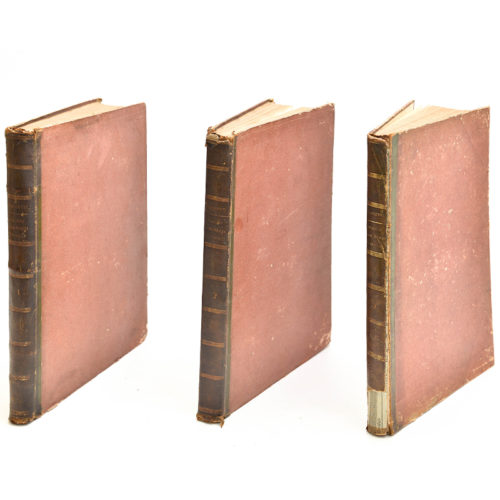 Three volumes entitled "Romantic pictorial journey of the western provinces of ancient and modern Italy" by the lawyer Modesto Paroletti, a work adorned with lithographic perspective views drawn from life. Turin Felice Festa printing factory.Period: Early 19th century Measurements: L 31.5 x H 46 cm
Three volumes entitled "Romantic pictorial journey of the western provinces of ancient and modern Italy" by the lawyer Modesto Paroletti, a work adorned with lithographic perspective views drawn from life. Turin Felice Festa printing factory.Period: Early 19th century Measurements: L 31.5 x H 46 cm -
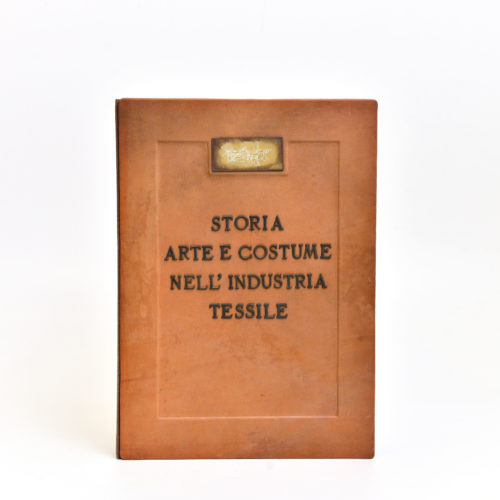 Wonderful collection numbered 129 out of 150 copies, of images by great Italian artists including A. Pomodoro, E. Baj, A. Bueno and many others 43 plates with images of the fabric manufacturing over the centuries, enclosed in a leather folder in excellent condition.Period: 20th century Measurements: H 50 x L 35 cm
Wonderful collection numbered 129 out of 150 copies, of images by great Italian artists including A. Pomodoro, E. Baj, A. Bueno and many others 43 plates with images of the fabric manufacturing over the centuries, enclosed in a leather folder in excellent condition.Period: 20th century Measurements: H 50 x L 35 cm
